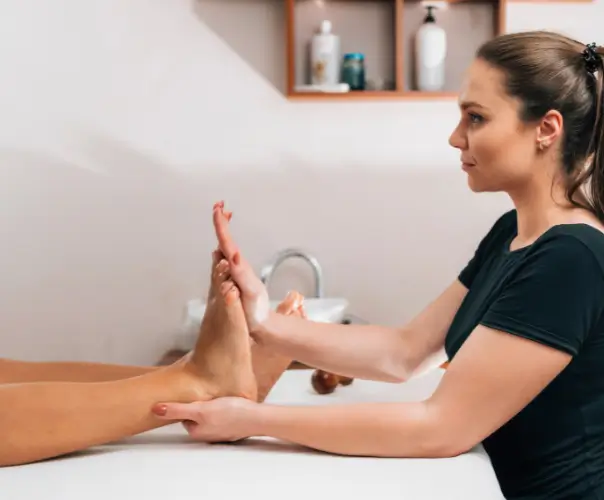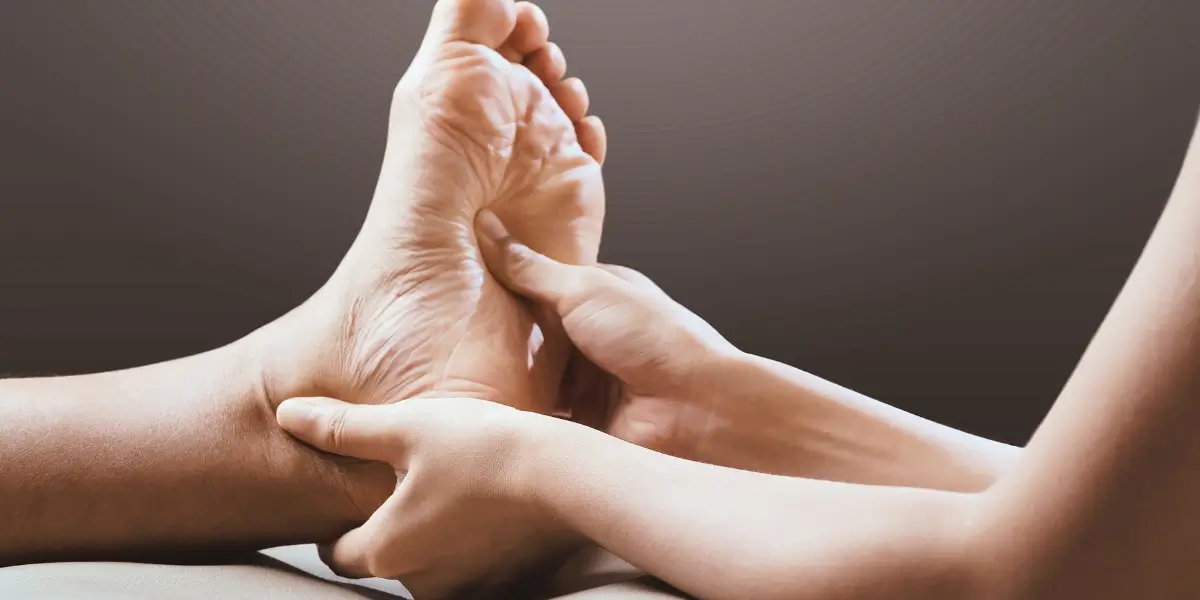Sep 2, 2022
Massage for sciatica?




First of all, you might be interested to know that sciatica is more common in people aged 30 to 50, so it's best to keep reading. According to various studies, 70 to 80% of patients will experience lower back pain at some point in their lives, and in 90% of cases, the cause lies in mechanical disorders of the spine.
First of all, you might be interested to know that sciatica is more common in people aged 30 to 50, so it's best to keep reading. According to various studies, 70 to 80% of patients will experience lower back pain at some point in their lives, and in 90% of cases, the cause lies in mechanical disorders of the spine.
First of all, you might be interested to know that sciatica is more common in people aged 30 to 50, so it's best to keep reading. According to various studies, 70 to 80% of patients will experience lower back pain at some point in their lives, and in 90% of cases, the cause lies in mechanical disorders of the spine.
First of all, you might be interested to know that sciatica is more common in people aged 30 to 50, so it's best to keep reading. According to various studies, 70 to 80% of patients will experience lower back pain at some point in their lives, and in 90% of cases, the cause lies in mechanical disorders of the spine.
Don't miss out on the best of Zen to Go! Receive exclusive offers and more items like this straight to your inbox.
Don't miss out on the best of Zen to Go! Receive exclusive offers and more items like this straight to your inbox.
Don't miss the best of Zen to Go! Receive more articles like this and exclusive offers directly to your email.
Don't miss out on the best of Zen to Go! Receive exclusive offers and more items like this straight to your inbox.
What is sciatica?
You might picture the scene where a person touches the lower part of their back and complains of pain, and you're on the right track; however, what is sciatica really?
The sciatic nerve is the largest nerve in the body and extends to each side of the lower spine, passing through the buttocks and the back of the thigh, reaching down to the foot.
The term sciatica refers to the pain caused when this nerve, the sciatic nerve, is pinched or irritated at the spinal level.
What are the causes of sciatica?
The most common cause of sciatica is a herniated disc in the lower back. We could say that the discs are like shock absorbers between the bones of the spine, and sometimes these discs crack, allowing the jelly-like substance inside to escape and irritate the surrounding nerves; in this case, the sciatic nerve.
However, there are other less common causes of sciatica, such as a bone spur on the vertebrae (excess bone growth), degenerative disc disease, diseases like diabetes, or even a tumor causing the compression of the sciatic nerve.
What are the symptoms of sciatica?
Sciatica can cause pain, numbness, tingling, weakness, and loss of reflexes in the lower back, buttocks, legs, and feet; generally affecting only one side of the body and potentially combining symptoms in different locations. For example, you might feel numbness in one buttock and pain in another part of the leg.
The intensity of the pain can vary from mild to sharp, even unbearable.
It might worsen when coughing or sneezing, and when sitting for long periods.
How can you tell if it's sciatica, low back pain, or piriformis syndrome?
There are several diagnoses for the same symptoms; for example, sciatica is not the same as low back pain or piriformis syndrome.
Sciatica: As mentioned before, it is when the sciatic nerve is pinched or irritated at the spinal level.
Low back pain: It is pain in the lumbar region that is generally felt suddenly after exerting oneself with poor posture or after a fall.
Piriformis syndrome: It is pain in the center of the buttock that occurs when the sciatic nerve is compressed by the piriformis muscle. It is sometimes called pseudo-sciatica or false sciatica.
Both in sciatica and in piriformis syndrome, the sciatic nerve is compressed or irritated; however, it is essential to locate the site of the compression to provide an accurate diagnosis.
A doctor will perform a physical examination that usually includes the Lasègue maneuver, which tends to be positive in the case of sciatica and negative in the case of piriformis syndrome. This consists of lying on your back (supine) and, with the leg straight, raising it and determining if any pain is felt. If pain radiating down the limb appears between 30 and 60 degrees, it is considered positive, and the doctor may recommend further tests.
How to treat sciatica?
Generally, mild to moderate pain can be treated at home with some of these home remedies:
Apply heat and cold: Heat helps muscles relax, and cold reduces inflammation and pain. Start by applying cold compresses to the affected area for about 20 minutes, then apply warm compresses. You can continue alternating or stick with the one that brings you the most relief.
Do gentle and localized stretching: Any physical treatment that helps to soften the muscles around the sciatic nerve will help with the pain and may help you regain mobility. We recommend seeing a professional therapist for advice on the correct stretches to avoid counterproductive effects.
Moreover, since most of the time sciatica is caused by a herniated disc, the body tends to reabsorb the material of the disc causing the symptoms, and the symptoms typically disappear after a short period.
If the pain persists for more than a week or worsens progressively, consult your doctor.
How can massage therapy help with sciatica?³
When your abdominal muscles, lower back, or lower limb muscles are tense, they can add tension to the sciatic nerve.
Massages help relieve tension in these muscles, alleviating the pressure on the sciatic nerve.
Additionally, massages stimulate the release of endorphins and can lower cortisol levels, the stress hormone; improving mood, inducing relaxation, and relieving pain.
What massages are good for sciatica?
There is not much scientific evidence that one type of massage is more beneficial than another for relieving sciatica pain, so the choice is personal based on preferences. Here are some recommendations:
Deep tissue massage: This involves slow movements with greater pressure than in a relaxing massage, working the deeper layers of the muscles to reduce muscle tension. It is the most commonly used technique to treat low back pain.
Swedish or relaxing massage: Stimulates the nerves and connective tissues to release tension and promote relaxation.
Neuromuscular massage: Applies pressure directly to the "knots".
A certified therapist can offer you a personalized treatment focused on specific areas around the sciatic nerve to help relieve stress and reduce pain.
Going to a specialized center when you have sciatica pain can be a challenge. Fortunately, it is now possible to be seen by a professional in the comfort of your home.
How to book a home massage to treat sciatica?
If you're looking for a safe, comfortable, and professional solution to book a home massage to treat sciatica, the certified therapists at Zen to Go will be happy to assist you.
Our team is trained and ready to meet your needs.
Booking at Zen to Go is very easy, either through the website www.zentogo.com.mx or by downloading the app, available for iOS and Android.
You can customize your session by choosing technique, duration, and preferred gender of the therapist, being able to add notes about your ailment.
Selecting the preferred date and time is really simple, and you can see the availability of therapists in real-time.
Guarantee your reservation with a bank card through the renowned payment processor Stripe, or with Google and Apple Pay.
And enjoy a professional massage to treat sciatica in the comfort of your home.
If you think that you need more than one session, we recommend checking our packages to enjoy a volume discount, which you can find in the Gift Certificates section.
No content on this site, regardless of the date, should be used as a substitute for direct advice from your doctor.
Sources
¹ https://www.elsevier.es/en-revista-revista-medica-del-hospital-general-325-articulo-radiofrequency-thermocoagulation-in-chronic-low-S0185106316300622
² https://www.ncbi.nlm.nih.gov/books/NBK538173/
³ https://www.healthline.com/health/massage-for-sciatica#benefits
What is sciatica?
You might picture the scene where a person touches the lower part of their back and complains of pain, and you're on the right track; however, what is sciatica really?
The sciatic nerve is the largest nerve in the body and extends to each side of the lower spine, passing through the buttocks and the back of the thigh, reaching down to the foot.
The term sciatica refers to the pain caused when this nerve, the sciatic nerve, is pinched or irritated at the spinal level.
What are the causes of sciatica?
The most common cause of sciatica is a herniated disc in the lower back. We could say that the discs are like shock absorbers between the bones of the spine, and sometimes these discs crack, allowing the jelly-like substance inside to escape and irritate the surrounding nerves; in this case, the sciatic nerve.
However, there are other less common causes of sciatica, such as a bone spur on the vertebrae (excess bone growth), degenerative disc disease, diseases like diabetes, or even a tumor causing the compression of the sciatic nerve.
What are the symptoms of sciatica?
Sciatica can cause pain, numbness, tingling, weakness, and loss of reflexes in the lower back, buttocks, legs, and feet; generally affecting only one side of the body and potentially combining symptoms in different locations. For example, you might feel numbness in one buttock and pain in another part of the leg.
The intensity of the pain can vary from mild to sharp, even unbearable.
It might worsen when coughing or sneezing, and when sitting for long periods.
How can you tell if it's sciatica, low back pain, or piriformis syndrome?
There are several diagnoses for the same symptoms; for example, sciatica is not the same as low back pain or piriformis syndrome.
Sciatica: As mentioned before, it is when the sciatic nerve is pinched or irritated at the spinal level.
Low back pain: It is pain in the lumbar region that is generally felt suddenly after exerting oneself with poor posture or after a fall.
Piriformis syndrome: It is pain in the center of the buttock that occurs when the sciatic nerve is compressed by the piriformis muscle. It is sometimes called pseudo-sciatica or false sciatica.
Both in sciatica and in piriformis syndrome, the sciatic nerve is compressed or irritated; however, it is essential to locate the site of the compression to provide an accurate diagnosis.
A doctor will perform a physical examination that usually includes the Lasègue maneuver, which tends to be positive in the case of sciatica and negative in the case of piriformis syndrome. This consists of lying on your back (supine) and, with the leg straight, raising it and determining if any pain is felt. If pain radiating down the limb appears between 30 and 60 degrees, it is considered positive, and the doctor may recommend further tests.
How to treat sciatica?
Generally, mild to moderate pain can be treated at home with some of these home remedies:
Apply heat and cold: Heat helps muscles relax, and cold reduces inflammation and pain. Start by applying cold compresses to the affected area for about 20 minutes, then apply warm compresses. You can continue alternating or stick with the one that brings you the most relief.
Do gentle and localized stretching: Any physical treatment that helps to soften the muscles around the sciatic nerve will help with the pain and may help you regain mobility. We recommend seeing a professional therapist for advice on the correct stretches to avoid counterproductive effects.
Moreover, since most of the time sciatica is caused by a herniated disc, the body tends to reabsorb the material of the disc causing the symptoms, and the symptoms typically disappear after a short period.
If the pain persists for more than a week or worsens progressively, consult your doctor.
How can massage therapy help with sciatica?³
When your abdominal muscles, lower back, or lower limb muscles are tense, they can add tension to the sciatic nerve.
Massages help relieve tension in these muscles, alleviating the pressure on the sciatic nerve.
Additionally, massages stimulate the release of endorphins and can lower cortisol levels, the stress hormone; improving mood, inducing relaxation, and relieving pain.
What massages are good for sciatica?
There is not much scientific evidence that one type of massage is more beneficial than another for relieving sciatica pain, so the choice is personal based on preferences. Here are some recommendations:
Deep tissue massage: This involves slow movements with greater pressure than in a relaxing massage, working the deeper layers of the muscles to reduce muscle tension. It is the most commonly used technique to treat low back pain.
Swedish or relaxing massage: Stimulates the nerves and connective tissues to release tension and promote relaxation.
Neuromuscular massage: Applies pressure directly to the "knots".
A certified therapist can offer you a personalized treatment focused on specific areas around the sciatic nerve to help relieve stress and reduce pain.
Going to a specialized center when you have sciatica pain can be a challenge. Fortunately, it is now possible to be seen by a professional in the comfort of your home.
How to book a home massage to treat sciatica?
If you're looking for a safe, comfortable, and professional solution to book a home massage to treat sciatica, the certified therapists at Zen to Go will be happy to assist you.
Our team is trained and ready to meet your needs.
Booking at Zen to Go is very easy, either through the website www.zentogo.com.mx or by downloading the app, available for iOS and Android.
You can customize your session by choosing technique, duration, and preferred gender of the therapist, being able to add notes about your ailment.
Selecting the preferred date and time is really simple, and you can see the availability of therapists in real-time.
Guarantee your reservation with a bank card through the renowned payment processor Stripe, or with Google and Apple Pay.
And enjoy a professional massage to treat sciatica in the comfort of your home.
If you think that you need more than one session, we recommend checking our packages to enjoy a volume discount, which you can find in the Gift Certificates section.
No content on this site, regardless of the date, should be used as a substitute for direct advice from your doctor.
Sources
¹ https://www.elsevier.es/en-revista-revista-medica-del-hospital-general-325-articulo-radiofrequency-thermocoagulation-in-chronic-low-S0185106316300622
² https://www.ncbi.nlm.nih.gov/books/NBK538173/
³ https://www.healthline.com/health/massage-for-sciatica#benefits
What is sciatica?
You might picture the scene where a person touches the lower part of their back and complains of pain, and you're on the right track; however, what is sciatica really?
The sciatic nerve is the largest nerve in the body and extends to each side of the lower spine, passing through the buttocks and the back of the thigh, reaching down to the foot.
The term sciatica refers to the pain caused when this nerve, the sciatic nerve, is pinched or irritated at the spinal level.
What are the causes of sciatica?
The most common cause of sciatica is a herniated disc in the lower back. We could say that the discs are like shock absorbers between the bones of the spine, and sometimes these discs crack, allowing the jelly-like substance inside to escape and irritate the surrounding nerves; in this case, the sciatic nerve.
However, there are other less common causes of sciatica, such as a bone spur on the vertebrae (excess bone growth), degenerative disc disease, diseases like diabetes, or even a tumor causing the compression of the sciatic nerve.
What are the symptoms of sciatica?
Sciatica can cause pain, numbness, tingling, weakness, and loss of reflexes in the lower back, buttocks, legs, and feet; generally affecting only one side of the body and potentially combining symptoms in different locations. For example, you might feel numbness in one buttock and pain in another part of the leg.
The intensity of the pain can vary from mild to sharp, even unbearable.
It might worsen when coughing or sneezing, and when sitting for long periods.
How can you tell if it's sciatica, low back pain, or piriformis syndrome?
There are several diagnoses for the same symptoms; for example, sciatica is not the same as low back pain or piriformis syndrome.
Sciatica: As mentioned before, it is when the sciatic nerve is pinched or irritated at the spinal level.
Low back pain: It is pain in the lumbar region that is generally felt suddenly after exerting oneself with poor posture or after a fall.
Piriformis syndrome: It is pain in the center of the buttock that occurs when the sciatic nerve is compressed by the piriformis muscle. It is sometimes called pseudo-sciatica or false sciatica.
Both in sciatica and in piriformis syndrome, the sciatic nerve is compressed or irritated; however, it is essential to locate the site of the compression to provide an accurate diagnosis.
A doctor will perform a physical examination that usually includes the Lasègue maneuver, which tends to be positive in the case of sciatica and negative in the case of piriformis syndrome. This consists of lying on your back (supine) and, with the leg straight, raising it and determining if any pain is felt. If pain radiating down the limb appears between 30 and 60 degrees, it is considered positive, and the doctor may recommend further tests.
How to treat sciatica?
Generally, mild to moderate pain can be treated at home with some of these home remedies:
Apply heat and cold: Heat helps muscles relax, and cold reduces inflammation and pain. Start by applying cold compresses to the affected area for about 20 minutes, then apply warm compresses. You can continue alternating or stick with the one that brings you the most relief.
Do gentle and localized stretching: Any physical treatment that helps to soften the muscles around the sciatic nerve will help with the pain and may help you regain mobility. We recommend seeing a professional therapist for advice on the correct stretches to avoid counterproductive effects.
Moreover, since most of the time sciatica is caused by a herniated disc, the body tends to reabsorb the material of the disc causing the symptoms, and the symptoms typically disappear after a short period.
If the pain persists for more than a week or worsens progressively, consult your doctor.
How can massage therapy help with sciatica?³
When your abdominal muscles, lower back, or lower limb muscles are tense, they can add tension to the sciatic nerve.
Massages help relieve tension in these muscles, alleviating the pressure on the sciatic nerve.
Additionally, massages stimulate the release of endorphins and can lower cortisol levels, the stress hormone; improving mood, inducing relaxation, and relieving pain.
What massages are good for sciatica?
There is not much scientific evidence that one type of massage is more beneficial than another for relieving sciatica pain, so the choice is personal based on preferences. Here are some recommendations:
Deep tissue massage: This involves slow movements with greater pressure than in a relaxing massage, working the deeper layers of the muscles to reduce muscle tension. It is the most commonly used technique to treat low back pain.
Swedish or relaxing massage: Stimulates the nerves and connective tissues to release tension and promote relaxation.
Neuromuscular massage: Applies pressure directly to the "knots".
A certified therapist can offer you a personalized treatment focused on specific areas around the sciatic nerve to help relieve stress and reduce pain.
Going to a specialized center when you have sciatica pain can be a challenge. Fortunately, it is now possible to be seen by a professional in the comfort of your home.
How to book a home massage to treat sciatica?
If you're looking for a safe, comfortable, and professional solution to book a home massage to treat sciatica, the certified therapists at Zen to Go will be happy to assist you.
Our team is trained and ready to meet your needs.
Booking at Zen to Go is very easy, either through the website www.zentogo.com.mx or by downloading the app, available for iOS and Android.
You can customize your session by choosing technique, duration, and preferred gender of the therapist, being able to add notes about your ailment.
Selecting the preferred date and time is really simple, and you can see the availability of therapists in real-time.
Guarantee your reservation with a bank card through the renowned payment processor Stripe, or with Google and Apple Pay.
And enjoy a professional massage to treat sciatica in the comfort of your home.
If you think that you need more than one session, we recommend checking our packages to enjoy a volume discount, which you can find in the Gift Certificates section.
No content on this site, regardless of the date, should be used as a substitute for direct advice from your doctor.
Sources
¹ https://www.elsevier.es/en-revista-revista-medica-del-hospital-general-325-articulo-radiofrequency-thermocoagulation-in-chronic-low-S0185106316300622
² https://www.ncbi.nlm.nih.gov/books/NBK538173/
³ https://www.healthline.com/health/massage-for-sciatica#benefits
What is sciatica?
You might picture the scene where a person touches the lower part of their back and complains of pain, and you're on the right track; however, what is sciatica really?
The sciatic nerve is the largest nerve in the body and extends to each side of the lower spine, passing through the buttocks and the back of the thigh, reaching down to the foot.
The term sciatica refers to the pain caused when this nerve, the sciatic nerve, is pinched or irritated at the spinal level.
What are the causes of sciatica?
The most common cause of sciatica is a herniated disc in the lower back. We could say that the discs are like shock absorbers between the bones of the spine, and sometimes these discs crack, allowing the jelly-like substance inside to escape and irritate the surrounding nerves; in this case, the sciatic nerve.
However, there are other less common causes of sciatica, such as a bone spur on the vertebrae (excess bone growth), degenerative disc disease, diseases like diabetes, or even a tumor causing the compression of the sciatic nerve.
What are the symptoms of sciatica?
Sciatica can cause pain, numbness, tingling, weakness, and loss of reflexes in the lower back, buttocks, legs, and feet; generally affecting only one side of the body and potentially combining symptoms in different locations. For example, you might feel numbness in one buttock and pain in another part of the leg.
The intensity of the pain can vary from mild to sharp, even unbearable.
It might worsen when coughing or sneezing, and when sitting for long periods.
How can you tell if it's sciatica, low back pain, or piriformis syndrome?
There are several diagnoses for the same symptoms; for example, sciatica is not the same as low back pain or piriformis syndrome.
Sciatica: As mentioned before, it is when the sciatic nerve is pinched or irritated at the spinal level.
Low back pain: It is pain in the lumbar region that is generally felt suddenly after exerting oneself with poor posture or after a fall.
Piriformis syndrome: It is pain in the center of the buttock that occurs when the sciatic nerve is compressed by the piriformis muscle. It is sometimes called pseudo-sciatica or false sciatica.
Both in sciatica and in piriformis syndrome, the sciatic nerve is compressed or irritated; however, it is essential to locate the site of the compression to provide an accurate diagnosis.
A doctor will perform a physical examination that usually includes the Lasègue maneuver, which tends to be positive in the case of sciatica and negative in the case of piriformis syndrome. This consists of lying on your back (supine) and, with the leg straight, raising it and determining if any pain is felt. If pain radiating down the limb appears between 30 and 60 degrees, it is considered positive, and the doctor may recommend further tests.
How to treat sciatica?
Generally, mild to moderate pain can be treated at home with some of these home remedies:
Apply heat and cold: Heat helps muscles relax, and cold reduces inflammation and pain. Start by applying cold compresses to the affected area for about 20 minutes, then apply warm compresses. You can continue alternating or stick with the one that brings you the most relief.
Do gentle and localized stretching: Any physical treatment that helps to soften the muscles around the sciatic nerve will help with the pain and may help you regain mobility. We recommend seeing a professional therapist for advice on the correct stretches to avoid counterproductive effects.
Moreover, since most of the time sciatica is caused by a herniated disc, the body tends to reabsorb the material of the disc causing the symptoms, and the symptoms typically disappear after a short period.
If the pain persists for more than a week or worsens progressively, consult your doctor.
How can massage therapy help with sciatica?³
When your abdominal muscles, lower back, or lower limb muscles are tense, they can add tension to the sciatic nerve.
Massages help relieve tension in these muscles, alleviating the pressure on the sciatic nerve.
Additionally, massages stimulate the release of endorphins and can lower cortisol levels, the stress hormone; improving mood, inducing relaxation, and relieving pain.
What massages are good for sciatica?
There is not much scientific evidence that one type of massage is more beneficial than another for relieving sciatica pain, so the choice is personal based on preferences. Here are some recommendations:
Deep tissue massage: This involves slow movements with greater pressure than in a relaxing massage, working the deeper layers of the muscles to reduce muscle tension. It is the most commonly used technique to treat low back pain.
Swedish or relaxing massage: Stimulates the nerves and connective tissues to release tension and promote relaxation.
Neuromuscular massage: Applies pressure directly to the "knots".
A certified therapist can offer you a personalized treatment focused on specific areas around the sciatic nerve to help relieve stress and reduce pain.
Going to a specialized center when you have sciatica pain can be a challenge. Fortunately, it is now possible to be seen by a professional in the comfort of your home.
How to book a home massage to treat sciatica?
If you're looking for a safe, comfortable, and professional solution to book a home massage to treat sciatica, the certified therapists at Zen to Go will be happy to assist you.
Our team is trained and ready to meet your needs.
Booking at Zen to Go is very easy, either through the website www.zentogo.com.mx or by downloading the app, available for iOS and Android.
You can customize your session by choosing technique, duration, and preferred gender of the therapist, being able to add notes about your ailment.
Selecting the preferred date and time is really simple, and you can see the availability of therapists in real-time.
Guarantee your reservation with a bank card through the renowned payment processor Stripe, or with Google and Apple Pay.
And enjoy a professional massage to treat sciatica in the comfort of your home.
If you think that you need more than one session, we recommend checking our packages to enjoy a volume discount, which you can find in the Gift Certificates section.
No content on this site, regardless of the date, should be used as a substitute for direct advice from your doctor.
Sources
¹ https://www.elsevier.es/en-revista-revista-medica-del-hospital-general-325-articulo-radiofrequency-thermocoagulation-in-chronic-low-S0185106316300622
² https://www.ncbi.nlm.nih.gov/books/NBK538173/
³ https://www.healthline.com/health/massage-for-sciatica#benefits
You may also be interested in
Discover Our Home Services
💆 Massages and facials at home in various cities in Mexico 🌟

Swedish Massage
The relaxing massage combines gentle movements to release tension and calm the body and mind.

Deep Tissue Massage
Deep tissue massage uses firm pressure and slow techniques to work on the deeper layers of muscle.

Sports Massage
Sports massage combines specialized techniques to prevent injuries, relieve tension, and optimize muscle recovery.

Lymphatic Drainage Massage
Lymphatic drainage massage uses gentle, rhythmic movements to stimulate the lymphatic system, reduce fluid retention, and detoxify the body.

Prenatal Massage
Prenatal massage relieves tension, reduces swelling, and improves the well-being of both the mother and the baby using safe techniques adapted for pregnancy.

Reflexology
Reflexology uses the stimulation of specific points to promote relaxation, improve circulation, and balance overall well-being.

Couples Massage
Custom pressure for each. Ideal for couples looking to reduce stress and enjoy well-being at home.

Fiesta SPA
Experience an unforgettable time with massages and facials, perfect for relaxing with your friends at your spa party or event.
Discover Our Home Services
💆 Massages and facials at home in various cities in Mexico 🌟

Swedish Massage
The relaxing massage combines gentle movements to release tension and calm the body and mind.

Deep Tissue Massage
Deep tissue massage uses firm pressure and slow techniques to work on the deeper layers of muscle.

Sports Massage
Sports massage combines specialized techniques to prevent injuries, relieve tension, and optimize muscle recovery.

Lymphatic Drainage Massage
Lymphatic drainage massage uses gentle, rhythmic movements to stimulate the lymphatic system, reduce fluid retention, and detoxify the body.

Prenatal Massage
Prenatal massage relieves tension, reduces swelling, and improves the well-being of both the mother and the baby using safe techniques adapted for pregnancy.

Reflexology
Reflexology uses the stimulation of specific points to promote relaxation, improve circulation, and balance overall well-being.

Couples Massage
Custom pressure for each. Ideal for couples looking to reduce stress and enjoy well-being at home.

Fiesta SPA
Experience an unforgettable time with massages and facials, perfect for relaxing with your friends at your spa party or event.
Discover Our Home Services
💆 Massages and facials at home in various cities in Mexico 🌟

Swedish Massage
The relaxing massage combines gentle movements to release tension and calm the body and mind.

Deep Tissue Massage
Deep tissue massage uses firm pressure and slow techniques to work on the deeper layers of muscle.

Sports Massage
Sports massage combines specialized techniques to prevent injuries, relieve tension, and optimize muscle recovery.

Lymphatic Drainage Massage
Lymphatic drainage massage uses gentle, rhythmic movements to stimulate the lymphatic system, reduce fluid retention, and detoxify the body.

Prenatal Massage
Prenatal massage relieves tension, reduces swelling, and improves the well-being of both the mother and the baby using safe techniques adapted for pregnancy.

Reflexology
Reflexology uses the stimulation of specific points to promote relaxation, improve circulation, and balance overall well-being.

Couples Massage
Custom pressure for each. Ideal for couples looking to reduce stress and enjoy well-being at home.

Fiesta SPA
Experience an unforgettable time with massages and facials, perfect for relaxing with your friends at your spa party or event.
Discover Our Home Services
💆 Massages and facials at home in various cities in Mexico 🌟

Swedish Massage
The relaxing massage combines gentle movements to release tension and calm the body and mind.

Deep Tissue Massage
Deep tissue massage uses firm pressure and slow techniques to work on the deeper layers of muscle.

Sports Massage
Sports massage combines specialized techniques to prevent injuries, relieve tension, and optimize muscle recovery.

Lymphatic Drainage Massage
Lymphatic drainage massage uses gentle, rhythmic movements to stimulate the lymphatic system, reduce fluid retention, and detoxify the body.

Prenatal Massage
Prenatal massage relieves tension, reduces swelling, and improves the well-being of both the mother and the baby using safe techniques adapted for pregnancy.

Reflexology
Reflexology uses the stimulation of specific points to promote relaxation, improve circulation, and balance overall well-being.

Couples Massage
Custom pressure for each. Ideal for couples looking to reduce stress and enjoy well-being at home.

Fiesta SPA
Experience an unforgettable time with massages and facials, perfect for relaxing with your friends at your spa party or event.
Schedule My Home Massage
Our customer service often exceeds expectations, providing an unmatched experience.
Certified therapists from the best SPAs in the city
No penalties if you cancel 24 hours before your service.
7 out of 10 local customers return and become frequent customers.
Schedule My Home Massage
Our customer service often exceeds expectations, providing an unmatched experience.
Certified therapists from the best SPAs in the city
No penalties if you cancel 24 hours before your service.
7 out of 10 local customers return and become frequent customers.
Schedule My Home Massage
Our customer service often exceeds expectations, providing an unmatched experience.
Certified therapists from the best SPAs in the city
No penalties if you cancel 24 hours before your service.
7 out of 10 local customers return and become frequent customers.
Schedule My Home Massage
Our customer service often exceeds expectations, providing an unmatched experience.
Certified therapists from the best SPAs in the city
No penalties if you cancel 24 hours before your service.
7 out of 10 local customers return and become frequent customers.

We are Home Wellness. We connect you with the best therapists in the city conveniently and securely, so you can say goodbye to stress.
Contact us via your preferred channel:
Work with us
Services
© 2019-2025 Zen to Go™. All rights reserved. Zen to Go is a registered trademark of Plataformas Zen México SA de CV.
Calle 38 Entre Av. 10 y 10 BIS, Local 12, Zazil-Ha, Playa del Carmen, Quintana Roo, CP 77720, México.

We are Home Wellness. We connect you with the best therapists in the city conveniently and securely, so you can say goodbye to stress.
Contact us via your preferred channel:
Work with us
Services
© 2019-2025 Zen to Go™. All rights reserved. Zen to Go is a registered trademark of Plataformas Zen México SA de CV.
Calle 38 Entre Av. 10 y 10 BIS, Local 12, Zazil-Ha, Playa del Carmen, Quintana Roo, CP 77720, México.

We are Home Wellness. We connect you with the best therapists in the city conveniently and securely, so you can say goodbye to stress.
Contact us via your preferred channel:
Work with us
Services
© 2019-2025 Zen to Go™. All rights reserved. Zen to Go is a registered trademark of Plataformas Zen México SA de CV.
Calle 38 Entre Av. 10 y 10 BIS, Local 12, Zazil-Ha, Playa del Carmen, Quintana Roo, CP 77720, México.

We are Home Wellness. We connect you with the best therapists in the city conveniently and securely, so you can say goodbye to stress.
Contact us via your preferred channel:
Work with us
Services
© 2019-2025 Zen to Go™. All rights reserved. Zen to Go is a registered trademark of Plataformas Zen México SA de CV.
Calle 38 Entre Av. 10 y 10 BIS, Local 12, Zazil-Ha, Playa del Carmen, Quintana Roo, CP 77720, México.



